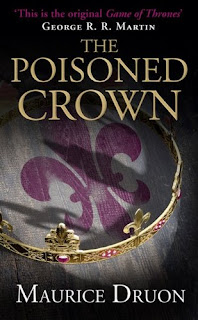By Paul Carrier
There’s a passage in the prologue to The Poisoned Crown, the third entry in Maurice Druon’s seven-part saga set in medieval France, that neatly sums up the scheming, duplicity, brutality and sheer stupidity at the heart of this impressive series of historical novels known, collectively, as The Accursed Kings.
Philip the Fair (King Philip IV) ruled France with strength, wisdom and vision for close to 30 years, until 1314. During his sometimes ruthless reign, France was the most powerful nation in Europe, but Philip’s passing introduced a dark age of sorts. It was a period in which, as Druon puts it, a “long succession of vain imbeciles” chipped away at Philip’s accomplishments and set the stage for the Hundred Years War. These “processes of decay” continued for a third of a century, Druon writes, but “it must be admitted that a great part of the destruction was completed during the first six months” following Philip’s death.
Enter Louis X, Philip’s stooped, sallow, first-born son and the man who inherited his throne. Hot-headed, insecure and incompetent, Louis moved to center stage in The Strangled Queen, book two in this series. His crippling deficiencies, including chronic indecisiveness, are on full display in The Poisoned Crown as he continues to trod his father’s impressive legacy underfoot.
Having arranged the murder of his unfaithful wife because he could not get his marriage annulled, Louis weds the beautiful Clémence of Hungary. But the Countess Mahout of Artois, a malevolent noblewoman whose daughter is married to the king’s brother, Philip, cooks up a plot to kill Louis and place her son-in-law on the throne. This being the Middle Ages, there is much talk of poisons and curses, spells and incantations.
A more lighthearted subplot, which is continued from earlier in the series, involves the clandestine love affair between an ambitious Italian banker and a beautiful but impoverished French noblewoman.
All this plays out against a backdrop of national disintegration, as Philip the Fair’s success in reining in regional warlords crumbles and France’s provincial, self-absorbed barons reclaim their lost powers.
The tale that unfolds in The Accursed Kings is all the more fascinating because it chronicles the decline of one of the greatest royal lines in French history. The House of Capet, whose ranks include Philip and Louis, ruled France for 13 generations and more than 300 years, from 987 to 1328.
Druon, who died in 2009, has been widely praised for the research and (generally speaking) historical accuracy that went into the writing of The Accursed Kings novels, which were first published in French from 1955 to 1977. Although they are works of fiction, the books include endnotes, some of them quite lengthy, that elaborate on various aspects of medieval life touched upon in the novels themselves.
The compelling (but rarely admirable) characters who people The Accursed Kings are a highlight of the series, but Druon also offers up intricate plots and a believable recreation of 14th-century France. In The Poisoned Crown, for example, the grim conditions at the Hôtel Dieu, a hospital in Marseilles, are described thus: “Religious exercises were intimately related to medical treatment; the groans of the sufferers were mingled with verses of the psalms; the odor of incense could not overcome the atrocious smell of fever and gangrene; death was a public spectacle.”
The Accursed Kings novels are not swashbuckling tales, at least in the case of the first three books. (I’m working my way through the series in chronological order.) But they are similar in tone to such historical adventures as The Three Musketeers. In fact, George R. R. Martin, author of the fantasy series A Song of Ice and Fire, has described Druon as “France’s best historical novelist since Alexandre Dumas, père.”
While the novels place a greater emphasis on high drama than wit, Druon peppers The Accursed Kings with dry, astute reflections that may bring a smile to readers' lips. When a likable but unimpressive member of the royal court is awarded an important job near the end of The Poisoned Crown, for example, Druon explains: "It is one of the advantages of mediocrity that people frequently decide unanimously upon your name." Anyone familiar with contemporary politics can attest to the continued truth of that statement.
While the novels place a greater emphasis on high drama than wit, Druon peppers The Accursed Kings with dry, astute reflections that may bring a smile to readers' lips. When a likable but unimpressive member of the royal court is awarded an important job near the end of The Poisoned Crown, for example, Druon explains: "It is one of the advantages of mediocrity that people frequently decide unanimously upon your name." Anyone familiar with contemporary politics can attest to the continued truth of that statement.
“The Accursed Kings has it all,” Martin writes in a forward. “Iron kings and strangled queens, battles and betrayals, lies and lust, deception, family rivalries, the curse of the Templars, babies switched at birth, she wolves, sin, and swords, the doom of a great dynasty . . . .” The history that Druon fictionalizes in these pages was, according to Martin, “the original game of thrones.”

